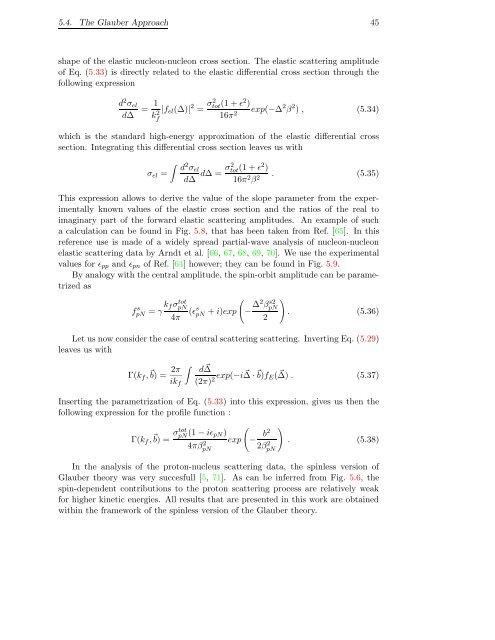Download Thesis in Pdf Format - Theoretical Nuclear Physics and ...
Download Thesis in Pdf Format - Theoretical Nuclear Physics and ...
Download Thesis in Pdf Format - Theoretical Nuclear Physics and ...
Create successful ePaper yourself
Turn your PDF publications into a flip-book with our unique Google optimized e-Paper software.
5.4. The Glauber Approach 45<br />
shape of the elastic nucleon-nucleon cross section. The elastic scatter<strong>in</strong>g amplitude<br />
of Eq. (5.33) is directly related to the elastic differential cross section through the<br />
follow<strong>in</strong>g expression<br />
d 2 σ el<br />
d∆<br />
= 1 k 2 f<br />
|f el (∆)| 2 = σ2 tot(1 + ɛ 2 )<br />
16π 2 exp(−∆ 2 β 2 ) , (5.34)<br />
which is the st<strong>and</strong>ard high-energy approximation of the elastic differential cross<br />
section. Integrat<strong>in</strong>g this differential cross section leaves us with<br />
σ el =<br />
∫ d 2 σ el<br />
d∆ d∆ = σ2 tot(1 + ɛ 2 )<br />
16π 2 β 2 . (5.35)<br />
This expression allows to derive the value of the slope parameter from the experimentally<br />
known values of the elastic cross section <strong>and</strong> the ratios of the real to<br />
imag<strong>in</strong>ary part of the forward elastic scatter<strong>in</strong>g amplitudes. An example of such<br />
a calculation can be found <strong>in</strong> Fig. 5.8, that has been taken from Ref. [65]. In this<br />
reference use is made of a widely spread partial-wave analysis of nucleon-nucleon<br />
elastic scatter<strong>in</strong>g data by Arndt et al. [66, 67, 68, 69, 70]. We use the experimental<br />
values for ɛ pp <strong>and</strong> ɛ pn of Ref. [64] however; they can be found <strong>in</strong> Fig. 5.9.<br />
By analogy with the central amplitude, the sp<strong>in</strong>-orbit amplitude can be parametrized<br />
as<br />
fpN s = γ k f σpN<br />
tot<br />
(<br />
4π<br />
(ɛs pN + i)exp − ∆2β pN<br />
s2 )<br />
. (5.36)<br />
2<br />
Let us now consider the case of central scatter<strong>in</strong>g scatter<strong>in</strong>g. Invert<strong>in</strong>g Eq. (5.29)<br />
leaves us with<br />
Γ(k f , ⃗ b) = 2π<br />
ik f<br />
∫<br />
d ⃗ ∆<br />
(2π) 2 exp(−i⃗ ∆ ·⃗b)f E ( ⃗ ∆) . (5.37)<br />
Insert<strong>in</strong>g the parametrization of Eq. (5.33) <strong>in</strong>to this expression, gives us then the<br />
follow<strong>in</strong>g expression for the profile function :<br />
Γ(k f , ⃗ b) = σtot pN (1 − iɛ (<br />
pN)<br />
exp −<br />
4πβ 2 pN<br />
b2<br />
2β 2 pN<br />
)<br />
. (5.38)<br />
In the analysis of the proton-nucleus scatter<strong>in</strong>g data, the sp<strong>in</strong>less version of<br />
Glauber theory was very succesfull [5, 71]. As can be <strong>in</strong>ferred from Fig. 5.6, the<br />
sp<strong>in</strong>-dependent contributions to the proton scatter<strong>in</strong>g process are relatively weak<br />
for higher k<strong>in</strong>etic energies. All results that are presented <strong>in</strong> this work are obta<strong>in</strong>ed<br />
with<strong>in</strong> the framework of the sp<strong>in</strong>less version of the Glauber theory.















